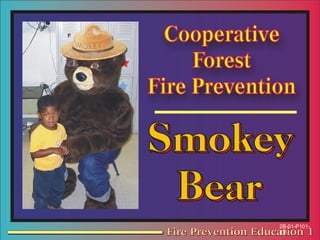
P 101 ep 2-b
- 2. Lesson Objectives • Utilize the CFFP program and name its various components • Explain the history of Smokey Bear and the policies for the program • Implement a Smokey Bear program 2B-02-P101- EP
- 3. Introduction • The Cooperative Forest Fire Prevention (CFFP) program, commonly known as the Smokey Bear program, was created to maintain a public awareness of the need to prevent wildfires. 2B-03-P101-EP
- 4. Introduction • The program is managed by the Forest Service with the Advertising Council, Inc. and the National Association of State Foresters. 2B-04-P101-EP
- 5. History of Smokey Bear • The guardian of the forest has been a part of the American scene for so many years it is hard to remember when he first appeared. 2B-05-P101-EP
- 6. History of Smokey Bear • Dressed in a ranger’s hat, belted blue jeans, and carrying a shovel, he has been the recognized wildfire prevention symbol since 1944. 2B-06-P101-EP
- 7. History of Smokey Bear • Today, Smokey Bear is a highly recognized advertising symbol and is protected by Federal law. PL 82-359 as amended by PL 92-318. He even has his own private Zip Code – 20252. 2B-07-P101-EP
- 8. “History of Smokey Bear” Video Presentation 2B-08-P101-EP
- 9. Smokey Bear Milestones • The 40th Birthday Celebration - 1984 2B-09-P101-EP
- 10. Smokey Bear Milestones • The 50th Birthday Celebration - 1994 2B-10-P101-EP
- 11. Smokey Bear Milestones • The 60th Birthday Celebration - 2004 2B-11-P101-EP
- 12. CFFP Program Objectives • Create and maintain a public awareness about wildfire prevention. 2B-12-P101-EP
- 13. CFFP Program Policy • The program provides a framework which can be expanded upon. • Using Smokey Bear for wildfire prevention messages stimulates active support. 2B-13-P101-EP
- 14. CFFP Program Policy • The official Forest Service policy and guidelines can be found in FSM Chapter 3110, Cooperative Fire Prevention (CFFP) and FSH 5109.18, Chapter 20. 2B-14-P101-EP
- 15. CFFP Program Responsibilities • CFFP Committee • The Ad Council • Washington Office – Forest Service • Regions and Area/USDA Forest Service • State Foresters 2B-15-P101-EP
- 16. CFFP Committee • 3 State Foresters • The Ad council • USDA – Forest Service • Meets 3 times a year • Sets direction 2B-16-P101-EP
- 17. The Ad Council • Has a professional Advertising firm • Work is reviewed before production • Quality is critical • Foote, Cone & Belding 2B-17-P101-EP
- 18. USDA Forest Service • Administers the program • Responsive to wildland fire prevention needs of all parties 2B-18-P101-EP
- 19. Regions and Areas - USFS • Assigns primary responsibility for program coordination. • Facilitates resolution of issues, concerns, implements programs of work, activities, and serves as liaison to the WO. 2B-19-P101-EP
- 20. State Foresters • Each State Forester must assign responsibility for managing the CFFP program. This may differ from state to state. 2B-20-P101-EP
- 21. CFFP Program Components 2B-21-P101-EP
- 22. Five Major Components • Public Service Advertising • Campaign and educational activities • Commercial licensing • Image and appearance • Awards and recognition 2B-22-P101-EP
- 23. Public Service Advertising • Presents messages to the public • Collateral materials • Ad Council creates and produces PSA • Foote, Cone & Belding 2B-23-P101-EP
- 24. Media • Radio and television • Newspaper and magazines • Other media • Field production • Resale prohibited 2B-24-P101-EP
- 25. Campaign/Educational Materials • Created to reinforce fire prevention • Campaign materials feature a wide range of material opportunities • Designed for all age groups • NASF • Distribution 2B-25-P101-EP
- 26. Field Production - Campaign Materials • Encouraged • Can meet a specific need • High standards apply • Insure uniformity of Smokey’s image • Only approved artwork can be used 2B-26-P101-EP
- 27. Educational Activities and Materials • Remind children of fire prevention responsibilities • Work with teachers • Old material should not be distributed 2B-27-P101-EP
- 28. Commercial Licensing • Communicates Smokey’s message • Maintain the integrity as a National symbol • Ensure products maintain standards of high quality • Generate funds 2B-28-P101-EP
- 29. Licensing Policy • The Director of A&FM, USDA-Forest Service is responsible for approving commercial licensing activities. • Day-to-day administration is contracted to a licensing contractor. 2B-29-P101-EP
- 30. Licensing Policy • The use of Smokey Bear as a proprietary brand name is prohibited. • Symbol will always be used in conjunction with an approved fire prevention message. • All licensed products will display the official logo. • Unauthorized use is punishable by law. 2B-30-P101-EP
- 31. Licensing Policy • Application/approval procedure • Official logo • All products are approved prior to production • The PMS color system is standard 2B-31-P101-EP
- 32. Licensing Policy • Smokey cannot endorse a product. • He may appear with a product, but his message is always wildfire prevention. • Violations 2B-32-P101-EP
- 33. Image and Appearance • Official approved artwork • Costume • Acquisition and use • Appearances • Care and maintenance 2B-33-P101-EP
- 34. Image and Appearance • Security and disposal • Trademark protection 2B-34-P101-EP
- 35. Character Appearance Guidelines • The costumed character’s popular image can be utilized in many ways to focus attention to fire/life safety education programs. 2B-35-P101-EP
- 36. Character Appearance Guidelines • 1-2 years old • 2-4 years old • 4 years old • 5 years old • 6-8 years old 2B-36-P101-EP
- 37. Character Appearance Guidelines • 9-13 years old • 13-21 years old • Adults 2B-37-P101-EP
- 38. Character Appearance Guidelines • School programs • Large crowds • Special education children 2B-38-P101-EP
- 39. Awards and Recognition • Objective • Policy • Description • Selection criteria • Nomination process 2B-39-P101-EP
- 40. Awards and Recognition • Other awards • Selection process • Source of supply 2B-40-P101-EP
- 41. Lesson Objectives • Be able to utilize the CFFP program and name its various components • Explain the history of Smokey Bear and the policies for his program • Implement a Smokey Bear program 2B-41-P101-EP
